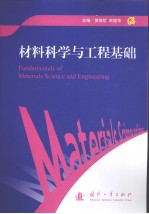

材料科学与工程基础 英文PDF电子书下载
- 电子书积分:9 积分如何计算积分?
- 作 者:黄根哲,朱振华主编
- 出 版 社:北京:国防工业出版社
- 出版年份:2010
- ISBN:9787118063493
- 页数:190 页
Chapter 1 Crystalline Structures and Imperfections 1
1.1 Introduction 1
1.2 Classification of Materials 1
1.3 Structure of Atoms 3
1.4 Ideal Crystal,Space Lattice and Unit Cells 4
1.5 Crystal Structures and Bravais Lattices 5
1.6 Cubic Unit Cells 6
1.7 Basic Crystalline Structures in Metals 7
1.8 Packing Factor 9
1.9 Directions and Planes in Crystalline Structures 10
1.9.1 Directions in Cubic Unit Cell 10
1.9.2 Miller Indices for Crystallographic Planes in Cubic Unit Cell 11
1.9.3 Linear Density and Planar Density in Crystalline Structures 12
1.10 Crystalline Imperfections 13
1.10.1 Point Defects 14
1.10.2 Linear Defects(Dislocations) 15
1.10.3 P1anar Defects(Grain Boundaries) 16
1.10.4 Metallographic Examination 17
Problems 18
Chapter 2 Mechanical Properties of Metals 21
2.1 Introduction 21
2.2 Materials Relationship 21
2.3 Tensile Properties 22
2.3.1 Linear-Elastic Region and Elastic Constants 23
2.3.2 Yield Point 24
2.3.3 Ultimate Tensile Strength 25
2.3.4 Measures of Ductility(Elongation and Reduction of Area) 26
2.4 Mechanism of Elastic and Plastic Deformation 27
2.4.1 Metallic Bond 27
2.4.2 Mechanism of Elastic Deformation 28
2.4.3 Mechanism of Plastic Deformation 29
2.5 Other Mechanical Properties 32
2.5.1 Compressive Properties 32
2.5.2 Shear Properties 33
2.5.3 Impact Toughness 33
2.6 Work Hardening 34
2.6.1 Annealing of Work-hardened Materials 36
2.6.2 Hot Working and Cold Working 38
2.7 Hardness Test 39
2.7.1 Introduction 39
2.7.2 Brinell Hardness Test 39
2.7.3 Rockwell Hardness Test 40
2.7.4 Vickers Hardness Test 41
2.7.5 Scleroscope Hardness Tests 43
Problems 43
Chapter 3 Binary Phase Diagram 45
3.1 Introduction 45
3.2 Metallic Solid Solutions 45
3.2.1 Substitutional Solid Solutions 46
3.2.2 Interstitial Solid Solutions 47
3.3 Binary Isomorphous Alloy Systems 48
3.4 Construction of Phase Diagrams 49
3.4.1 Cooling Curve 50
3.4.2 Experimental Methods to Determine Phase Change Points 51
3.5 Solidification of Solid Solution Alloy 52
3.6 Binary Eutectic Alloy Systems 54
3.6.1 Slow Cooling of a Pb-Sn Alloy of Eutectic Composition 55
3.6.2 Slow Cooling of a 65% Pb-35% Sn Alloy 56
3.6.3 Slow Cooling of a 16% Pb-84% Sn Alloy 56
3.7 Binary Eutectoid Reactions 57
3.8 Binary Peritectic Alloy Systems 58
3.9 Phase Diagram with Intermediate Phases and Compounds 60
Problems 61
Chapter 4 Iron-Carbon Equilibrium Diagram 63
4.1 Introduction 63
4.2 Polymorphism and Allotropy 64
4.3 Fe-Fe3C Phase Diagram 65
4.3.1 Effect of Carbon on the Fe-Fe3C Phase Diagram 65
4.3.2 Solid Phases in the Fe-Fe3C Phase Diagram 65
4.3.3 Transformation Temperatures and Lines 67
4.4 Invariant Reactions in the Fe-Fe3C Phase Diagram 68
4.5 Slow Cooling of Plain carbon Steels 68
4.5.1 Eutectoid Plain-carbon Steel 68
4.5.2 Hypoeutectoid Plain-carbon Steels 70
4.5.3 Hypereutectoid Plain-carbon Steels 72
4.6 Cast Irons 73
4.6.1 General Properties 73
4.6.2 Types of Cast Irons 74
Problems 79
Chapter 5 Heat Treatment of Steels 82
5.1 Introduction 82
5.1.1 Heating Temperatures and Time 82
5.1.2 Cooling Rates 83
5.2 Critical Temperatures 83
5.3 Time-Temperature-Transformation(TTT Diagram) 85
5.4 Microstructures at Fast Cooling 89
5.4.1 Bainite 89
5.4.2 Martensite 91
5.5 General Purposes of Heat Treatment 95
5.6 Types of Heat Treatment 96
5.6.1 Annealing 96
5.6.2 Normalizing 98
5.6.3 Hardening and Tempering 99
5.7 Case Hardening 108
5.7.1 Atomic Diffusion in Solids 108
5.7.2 Case Hardening of Steel by Gas Carburizing 110
Problems 111
Chapter 6 Carbon and Alloy Steels 113
6.1 Introduction 113
6.2 Plain-carbon Steels 114
6.2.1 AISI-SAE Classification System for Plain-carbon Steels 114
6.2.2 Chinese National Standard Classification System for Plain-carbon Steels 114
6.2.3 Characteristics and Applications of Plain-carbon Steels 117
6.3 Low-alloy Steels 119
6.3.1 Effect of Alloying Elements in Steels 119
6.3.2 Effects of Alloying Elements on the Critical Temperature of the Fe-Fe3C Diagram 123
6.3.3 Classification of Low-alloy Steels 125
6.4 Tool Steels 129
6.4.1 Water-hardening Tool Steels(W-type) 130
6.4.2 Shock-resistant Tool Steels(S-type) 131
6.4.3 Cold-work(Oil-hardening)Tool Steels(O-type) 132
6.4.4 Cold-work(Medium-alloy,Air-hardening)Tool Steels(A-type) 133
6.4.5 Cold-work(high-carbon,high-chromium)Tool Steels(D-type) 135
6.4.6 Hot-work Tool Steels(H-type) 136
6.4.7 High-speed Tool Steels(T and M types) 139
6.5 Stainless Steels 141
6.5.1 Ferritic Stainless Steels 142
6.5.2 Martensitic Stainless Steels 143
6.5.3 Austenitic Stainless Steels 143
6.5.4 Duplex Stainless Steels 144
6.6 Chinese National Standard Classification System for Alloy Steels 145
6.6.1 Low Alloy High Strength Structural Steels 145
6.6.2 Alloy Carburizing Steels 146
6.6.3 Quenched&High Temperature Tempered Alloy Steels 147
6.6.4 Alloy Spring Steels 149
6.6.5 Gear Steels 150
6.6.6 Alloy Tool Steels 151
6.6.7 High Speed Tool Steels 152
6.6.8 Stainless Steels 152
Problems 154
Chapter 7 Nonferrous Metals and Its Alloys 156
7.1 Introduction 156
7.2 Aluminum and Its Alloys 156
7.2.1 A1uminum Alloy Temper and Designation System 157
7.2.2 Aluminum Alloys and Their Characteristics 161
7.2.3 Precipitation Strengthening of Aluminum Alloys 163
7.2.4 Precipitation Strengthening of an Al-4% Cu Alloy 166
7.2.5 Aluminum Casting Alloys 170
7.3 Copper and Its Alloys 171
7.3.1 Introduction 171
7.3.2 Copper Alloys 172
7.4 Titanium and Its Alloys 173
7.4.1 Introduction 173
7.4.2 Pure Titanium 174
7.4.3 Titanium Alloy Systems and Phase Diagrams 174
7.4.4 Classification of Titanium Alloys 176
7.5 Magnesium and Its Alloys 177
7.5.1 Introduction 177
7.5.2 Classification of Magnesium Alloys 177
7.5.3 Structure and Properties 178
Problems 178
References 180
APPENDIX Ⅰ Definitions 182
APPENDIX Ⅱ Conversion Factors to SI Units 190
- 《市政工程基础》杨岚编著 2009
- 《零基础学会素描》王金著 2019
- 《计算机网络与通信基础》谢雨飞,田启川编著 2019
- 《生物质甘油共气化制氢基础研究》赵丽霞 2019
- 《花时间 我的第一堂花艺课 插花基础技法篇》(日)花时间编辑部编;陈洁责编;冯莹莹译 2020
- 《Photoshop CC 2018基础教程》温培利,付华编著 2019
- 《《走近科学》精选丛书 中国UFO悬案调查》郭之文 2019
- 《看视频零基础学英语口语》宋德伟 2019
- 《胃癌基础病理》(日)塚本彻哉编者;宫健,刘石译者 2019
- 《高校转型发展系列教材 素描基础与设计》施猛责任编辑;(中国)魏伏一,徐红 2019
- 《指向核心素养 北京十一学校名师教学设计 英语 七年级 上 配人教版》周志英总主编 2019
- 《北京生态环境保护》《北京环境保护丛书》编委会编著 2018
- 《指向核心素养 北京十一学校名师教学设计 英语 九年级 上 配人教版》周志英总主编 2019
- 《抗战三部曲 国防诗歌集》蒲风著 1937
- 《高等院校旅游专业系列教材 旅游企业岗位培训系列教材 新编北京导游英语》杨昆,鄢莉,谭明华 2019
- 《中国十大出版家》王震,贺越明著 1991
- 《近代民营出版机构的英语函授教育 以“商务、中华、开明”函授学校为个案 1915年-1946年版》丁伟 2017
- 《新工业时代 世界级工业家张毓强和他的“新石头记”》秦朔 2019
- 《智能制造高技能人才培养规划丛书 ABB工业机器人虚拟仿真教程》(中国)工控帮教研组 2019
- 《陶瓷工业节能减排技术丛书 陶瓷工业节能减排与污染综合治理》罗民华著 2017
